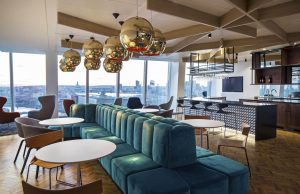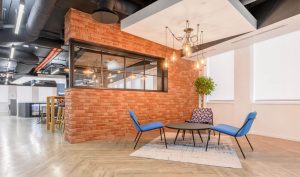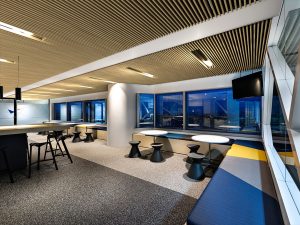On average, we spend around 30% of our time at work… but are we doing enough to maintain our physical and mental health during this time?
More and more research is being carried out to examine the effect of a building’s interior design on the well-being and productivity of its users. The working environment is often a stressful one, due to numerous factors such as having a lack of control, enclosed and poorly lit spaces, as well as noise and interruptions. Optimising workplace design could therefore lead to improved well-being among employees – which in turn leads to success!
Often a workplace will have one area for working and one for downtime, but how much effort is put in to distinguish the atmosphere of these separate areas, or to address the different working styles?
Creating alternative spaces specifically designed to maximise creativity and collaboration, rather than only having one area to work in for the entire day, will increase productivity. Spaces for ‘quiet time’ will be beneficial for workers who require heads-down concentration, and areas designed for fun and relaxation will rejuvenate workers and boost morale. Creating boundaries between these spaces can be achieved in a number of different ways, through changes in colour, furniture, materials and lighting.

Having interesting and eye-catching features within an interior is proven to create a more dynamic and inspiring environment. Much like we do at home, introducing different colours and textures, as well as photographs, sculptures and paintings is a fantastic way to relax workers and help them to stay alert.
Similarly, monotonous lighting or indeed a lack of light will automatically bring the mood down. Injecting light in a more creative way, through a change in levels, fixtures and the use of highlights to draw the eye to a particular feature, contributes towards this dynamic atmosphere. Varying textures and patterns through an imaginative selection of walls and ceilings can break up a space and make the working environment a more interesting and inviting prospect.

The rise of Generation Y must also be considered, with their desire to feel a sense of belonging and connection in all areas of life. This requires looking beyond productivity, considering the needs of the ‘whole self’ as opposed to just the ‘work self’. This calls for an environment that holistically affects the well-being of employees, creating contemporary interiors that make this generation proud of their workplace, and simultaneously bringing some of that comforting feel we get from home.

Poor acoustic control can also be a stress inducer. Creating the right acoustics can support the varying needs of workers, nurturing interaction or alternatively privacy wherever it may be required. Considering acoustical comfort can be done at the design stage, with a number of both aesthetically pleasing and functional sound-absorbing panel options.
Are you embarking on a new workplace design project?
Here at Vtec, we have experience in working within the scope of interior design to help create stunning interior solutions for a wide range of workplaces.